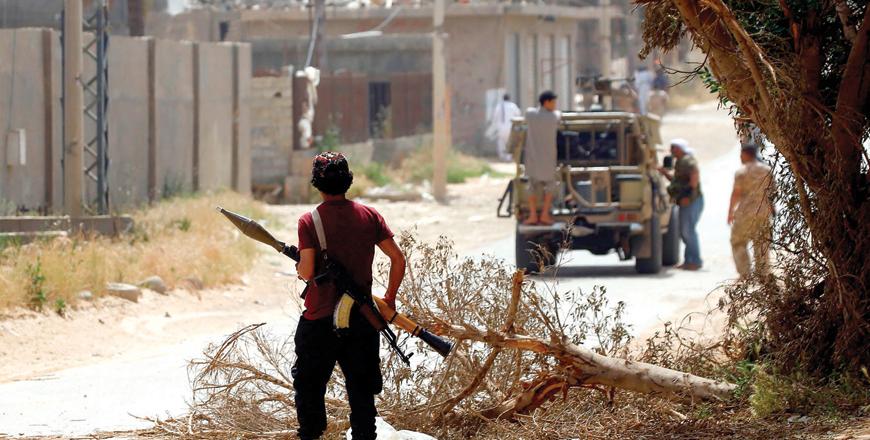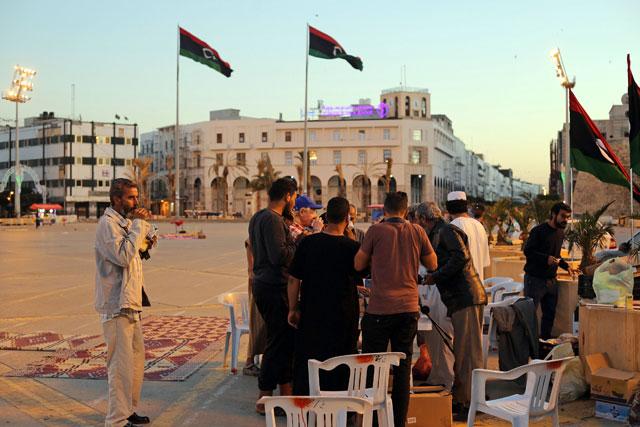You are here
Residential areas of Libya capital turning into 'battlefields' — ICRC
By AFP - Apr 25,2019 - Last updated at Apr 25,2019

Fighters loyal to the internationally recognised Government of National Accord get into position during clashes with forces loyal to strongman Khalifa Haftar, south of the capital Tripoli's suburb of Ain Zara, on Thursday (AFP photo)
TRIPOLI — Intensified fighting for control of the Libyan capital is turning residential areas of Tripoli into "battlefields", the International Committee of the Red Cross said Thursday.
"The humanitarian situation in and around Tripoli has deteriorated sharply over the past three weeks", since military strongman Khalifa Haftar launched an offensive on April 4 against forces loyal to the internationally recognised Government of National Accord (GNA), the ICRC said in a statement.
"More than 30,000 people are said to have fled their homes and are sheltering with relatives or in public buildings," it said, a figure which Libyan authorities and the United Nations say has risen to almost 35,000.
"Tripoli's basic services and infrastructure, such as hospitals and water pumping stations, which have already suffered from violence over the past eight years, are being weakened further", it said, referring to the insecurity in Libya since the 2011 uprising that ousted Muammar Qadhafi.
Youness Rahoui, the head of office in Tripoli for the ICRC, singled out the impact of the violence, which has focused on Tripoli's southern suburbs, on residents of the capital.
"One of our greatest concerns is for civilians living near the frontlines. Densely-populated residential areas are gradually turning into battlefields," Rahoui said.
He also said it was becoming "increasingly dangerous for medical workers to retrieve the wounded, with mounting reports of indiscriminate shelling".
At least 278 people have been killed and more than 1,300 wounded in the clashes, according to the latest casualty toll from the World Health Organisation.
Forces loyal to the GNA, which is based in Tripoli, launched a counterattack last weekend.
The UN voiced concern earlier this week that civilians had been trapped by shelling on densely populated parts of the city.
The International Organisation for Migration’s (IOM) Libya office also highlighted the plight of some 3,000 migrants held at detention centres in areas hit by fighting.
People traffickers have operated freely across much of Libya since the 2011 uprising and the country has become a major conduit for Sub-Saharan African migrants desperate to reach Europe.
The UN’s refugee agency UNHCR said it had evacuated 325 refugees from a centre in Qasr ben Ghachir on Wednesday night, a day after the IOM reported a “random shooting” at the centre south of Tripoli.
UNHCR said armed men had attacked migrants as they protested against conditions in the centre.
“There were no gunshot wounds, but 12 refugees suffered physical attacks that required hospital treatment,” it said.
The agency says it has transferred more than 825 migrants out of combat zones over the past two weeks.
Related Articles
TRIPOLI — Peering through the gate of a home in the western suburbs of Libya's war-torn capital, seven-year-old Chehab shyly looked on
TRIPOLI — Hundreds of migrants were still held Thursday in a centre days after it was hit by an air strike that killed 44 people, amid outra
TRIPOLI — Three Sudanese migrants were killed in a shooting in Libya after the country's coast guard intercepted them at sea and returned th


















